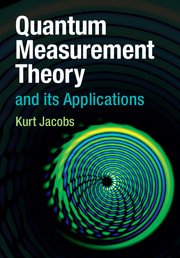Book contents
- Frontmatter
- Dedication
- Contents
- Preface
- 1 Quantum measurement theory
- 2 Useful concepts from information theory
- 3 Continuous measurement
- 4 Statistical mechanics, open systems, and measurement
- 5 Quantum feedback control
- 6 Metrology
- 7 Quantum mesoscopic systems I: circuits and measurements
- 8 Quantum mesoscopic systems II: measurement and control
- Appendix A The tensor product and partial trace
- Appendix B A fast-track introduction for experimentalists
- Appendix C A quick introduction to Ito calculus
- Appendix D Operators for qubits and modes
- Appendix E Dictionary of measurements
- Appendix F Input–output theory
- Appendix G Various formulae and techniques
- Appendix H Some proofs and derivations
- References
- Index
Appendix B - A fast-track introduction for experimentalists
Published online by Cambridge University Press: 05 September 2014
- Frontmatter
- Dedication
- Contents
- Preface
- 1 Quantum measurement theory
- 2 Useful concepts from information theory
- 3 Continuous measurement
- 4 Statistical mechanics, open systems, and measurement
- 5 Quantum feedback control
- 6 Metrology
- 7 Quantum mesoscopic systems I: circuits and measurements
- 8 Quantum mesoscopic systems II: measurement and control
- Appendix A The tensor product and partial trace
- Appendix B A fast-track introduction for experimentalists
- Appendix C A quick introduction to Ito calculus
- Appendix D Operators for qubits and modes
- Appendix E Dictionary of measurements
- Appendix F Input–output theory
- Appendix G Various formulae and techniques
- Appendix H Some proofs and derivations
- References
- Index
Summary
It is not necessary to understand the full structure of quantum measurement theory to understand quantum measurements in a wide range of experiments. This pedagogical approach was pointed out to me by Alexander Korotkov, and is the one he uses in his work on continuous measurements [343, 524, 638]. When we measure a single observable, and when this observable is not being changed during the measurement by any dynamics other than the measurement process, then only a small addition to Bayesian inference is required to describe quantum measurements. In fact, once we have made this addition, for infinitesimal time-steps we can include a Hamiltonian under which the measured observable changes with time, and obtain a full description of the continuous measurement of any quantum observable.
There is also another situation in which quantum measurement theory simplifies: when the system is linear, and when the observable being measured is a linear combination of the canonical coordinates. In this case, even when the observable is undergoing linear dynamics, a continuous quantum measurement reduces to a classical continuous measurement of a classical linear system, with the addition of a specified amount of white (flat-spectrum) noise. This noise is the “quantum back-action” of the measurement.
- Type
- Chapter
- Information
- Quantum Measurement Theory and its Applications , pp. 441 - 447Publisher: Cambridge University PressPrint publication year: 2014



